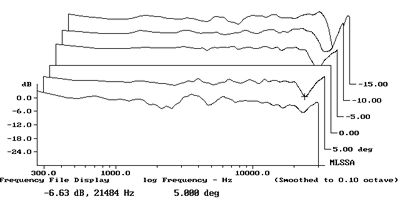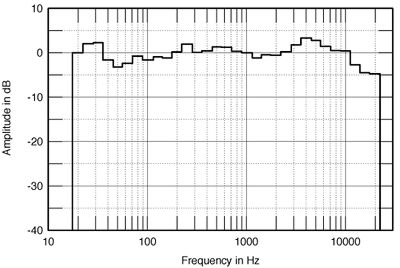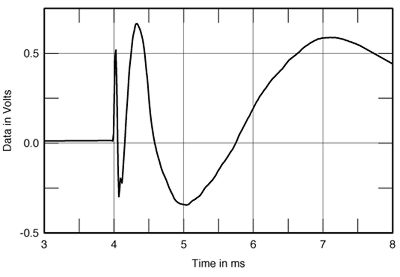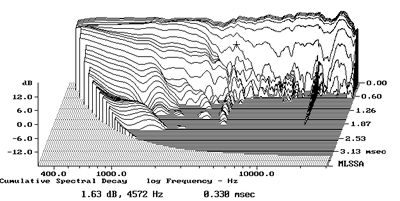| Columns Retired Columns & Blogs |
Sony ES SS-M9ED loudspeaker Measurements part 2
The same wide dispersion is also seen in the vertical plane (fig.7), though the on-axis peak above 20kHz drops back above and below the main tweeter axis. As the crossover between the tweeter and supertweeter is set at 22kHz, perhaps what we're seeing here is evidence that this crossover is optimized for the best integration slightly below the main axis. This is sensible, given that that axis is 39" from the floor when the speaker is fitted with its carpet-piercing spikes.

Fig.7 Sony ES SS-M9ED, vertical response family at 50", normalized to response on tweeter axis, from back to front: differences in response 15 degrees-5 degrees above reference axis; reference response; differences in response 5 degrees-10 degrees below reference axis.
It's in fig.8, a spatially averaged plot of the M9ED's balance at my listening position, where you'll see the best correlation between what I heard and what I measured. Superficially, the Sony's in-room response is almost as flat as that of the superb Revel Studio (see January 2001, p.183). Note the overall trend, however: The presence region is indeed boosted a little, and the upper- and midbass are both suppressed a bit. The result will be exactly the balance I noted: revealing but lacking warmth.

Fig.8 Sony ES SS-M9ED, spatially averaged, 1/3-octave response in JA's room.
I'm the first to admit that what happens in my listening room is not directly transferable to all rooms. I have arranged for my room to be relatively live though dispersive in character, which will not be kind to speakers with off-axis flares in the treble or presence regions. My room also tends to be bass-shy, at least in the 50Hz and 63Hz 1/3-octave bands. However, this graph does suggest that the Sony will work best in large rooms, or in smaller rooms that are relatively well-damped. The speaker's somewhat overdamped bass alignment means that it will also probably work better closer to the wall behind it than I was able to manage in my rather cluttered listening space.
In the time domain, the SS-M9ED's step response on the tweeter axis (fig.9) is absolutely typical of a design using high-order crossover filters. The outputs of the drive-units are all in the same, positive acoustic polarity, and, despite the setback of the front baffle, the output of the main tweeter arrives first at the measuring microphone, followed in turn by the midrange unit and the woofers. Peculiarly, I can't see the individual output of the supertweeter in this 30kHz-bandwidth graph, though it might be associated with the slight raggedness of the negative peak just past the 4ms mark.

Fig.9 Sony ES SS-M9ED, step response on tweeter axis at 50" (5ms time window, 30kHz bandwidth).
Finally, the SS-M9ED's waterfall plot (fig.10) is one of the best I have ever encountered. It is astonishingly clean, and almost completely free from delayed energy. No wonder I found the Sony's presentation to be so free from grain!—John Atkinson

Fig.10 Sony ES SS-M9ED, cumulative spectral-decay plot at 50" (0.15ms risetime).
- Log in or register to post comments




































